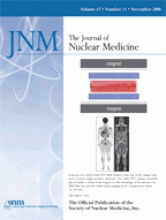REPLY: We thank Dr. Thie for his interest in our paper (1). Because we observed a very strong correlation between bone marrow standardized uptake value (SUV) and actual weight of the patient (as opposed to what was previously reported by Zasadny et al. (2) for a population of 28 females), we examined several approaches to calculate SUV, based mainly on lean body mass or body surface area, including those approaches reported by Sugawara et al. (3). We chose the method that showed the weakest correlation coefficient between weight and bone marrow SUV in our population—a method that turned out to be the one Dr. Thie accurately refers to as “female ideal body weight” in his letter.
Nevertheless, SUV calculations using either the male ideal body weight or the correct ideal body weight (f(H, sex)) gave similar results in correlation coefficients between bone marrow 18F-FDG uptake and weight (Table 1) and in the prognostic value of bone marrow hypermetabolism. This finding led us to the arguable choice of using a unique formula for the sake of simplicity in day-to-day clinical practice although possibly less accurate from a rigorous scientific point of view.
Effect of Correlation Parameter on SUV Calculation
Table 1 shows that, unlike Houseni et al. (4), we did not observe a significant correlation between bone marrow metabolism and patient age. We did observe a slight tendency toward a negative correlation but not reaching statistical significance. Moreover, the ratio of bone marrow activity to liver activity was obtained by comparing bone marrow metabolism to a patient's own liver, not to the livers of a healthy population. The only effect of a rising liver SUV with age would be a decrease in the likelihood of detecting abnormal bone marrow activity in older patients. However, as reported by El-Haddad et al. (5), there seemed to be a plateau after the fifth decade of life, an age group that comprises most lung cancer patients.
To evaluate the prognostic value of tumor SUV, most authors in the literature up to now have used the standard weight-corrected SUV. We preferred to use this approach as well, considering that this factor was one of the few, along with stage of disease-related variables, that were consistently reported in multivariate analyses in similar studies. Again, the calculation of the SUV with the correct ideal-body-weight approach provided a similar prognostic value.
We agree that multiple comparisons can sometimes be misleading for variables with borderline significance. The impact of the number of variables is more complex in multivariate analyses. To minimize this problem, we adhered to a rule of thumb that recommends that a Cox model should have at least 10 outcomes per variable included (6). According to the size of our sample (120 patients, 84 deaths), we would be allowed to include as many as 8 different factors in a single model. With the backward-deletion approach, a maximum of 10 factors was entered simultaneously in a model because variables that were obviously not independent were not all included. For example, among all the stage-related factors, only the most significant factor was included in the model (N factor). Using the forward-selection method, no more than 7 factors were entered simultaneously.
We are confident that the prognostic value of bone marrow hypermetabolism we reported is not just a statistical aberration but reflects some real underlying pathophysiologic processes. We certainly agree that further investigations are of interest to understand the physiology of 18F-FDG uptake in bone marrow. Dynamic acquisitions could shed additional light by decoupling uptake rate from distribution issues, but this was unfortunately not an option in a retrospective analysis of clinical scans.







